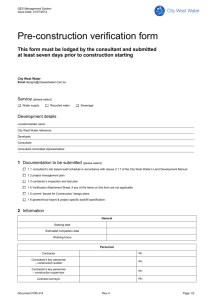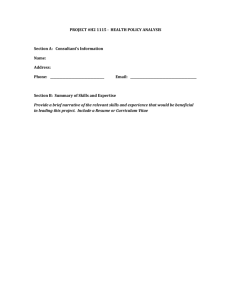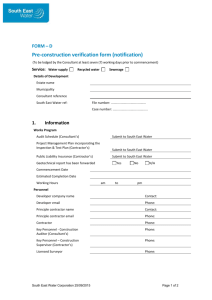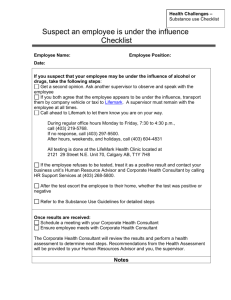3..
advertisement
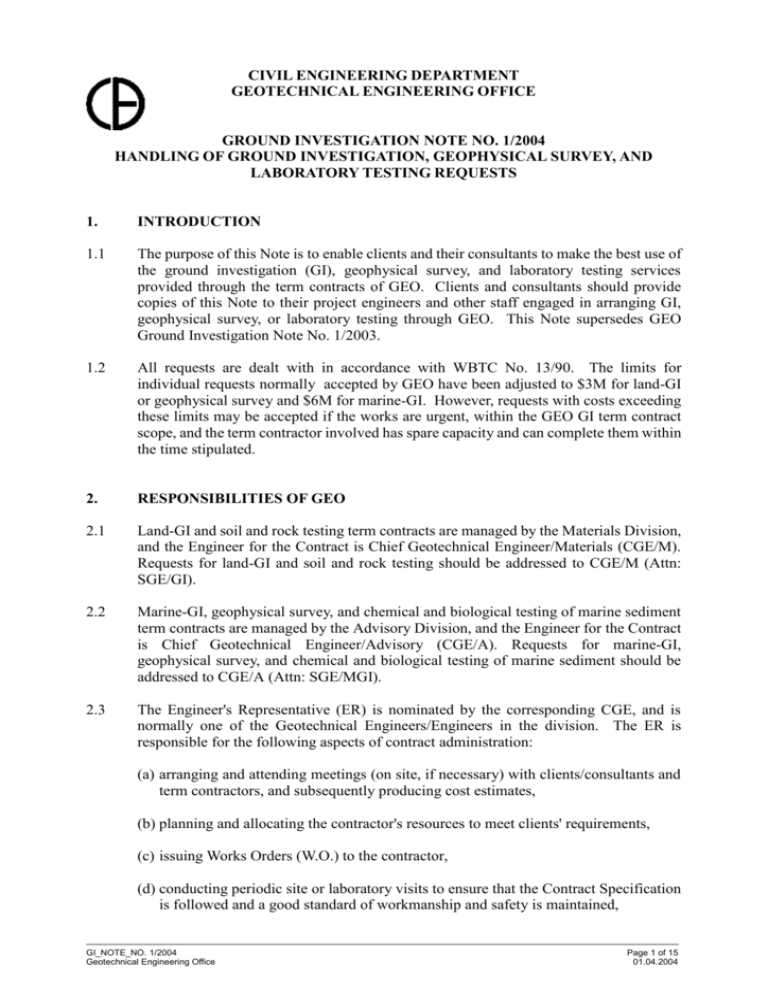
CIVIL ENGINEERING DEPARTMENT GEOTECHNICAL ENGINEERING OFFICE GROUND INVESTIGATION NOTE NO. 1/2004 HANDLING OF GROUND INVESTIGATION, GEOPHYSICAL SURVEY, AND LABORATORY TESTING REQUESTS 1. INTRODUCTION 1.1 The purpose of this Note is to enable clients and their consultants to make the best use of the ground investigation (GI), geophysical survey, and laboratory testing services provided through the term contracts of GEO. Clients and consultants should provide copies of this Note to their project engineers and other staff engaged in arranging GI, geophysical survey, or laboratory testing through GEO. This Note supersedes GEO Ground Investigation Note No. 1/2003. 1.2 All requests are dealt with in accordance with WBTC No. 13/90. The limits for individual requests normally accepted by GEO have been adjusted to $3M for land-GI or geophysical survey and $6M for marine-GI. However, requests with costs exceeding these limits may be accepted if the works are urgent, within the GEO GI term contract scope, and the term contractor involved has spare capacity and can complete them within the time stipulated. 2. RESPONSIBILITIES OF GEO 2.1 Land-GI and soil and rock testing term contracts are managed by the Materials Division, and the Engineer for the Contract is Chief Geotechnical Engineer/Materials (CGE/M). Requests for land-GI and soil and rock testing should be addressed to CGE/M (Attn: SGE/GI). 2.2 Marine-GI, geophysical survey, and chemical and biological testing of marine sediment term contracts are managed by the Advisory Division, and the Engineer for the Contract is Chief Geotechnical Engineer/Advisory (CGE/A). Requests for marine-GI, geophysical survey, and chemical and biological testing of marine sediment should be addressed to CGE/A (Attn: SGE/MGI). 2.3 The Engineer's Representative (ER) is nominated by the corresponding CGE, and is normally one of the Geotechnical Engineers/Engineers in the division. The ER is responsible for the following aspects of contract administration: (a) arranging and attending meetings (on site, if necessary) with clients/consultants and term contractors, and subsequently producing cost estimates, (b) planning and allocating the contractor's resources to meet clients' requirements, (c) issuing Works Orders (W.O.) to the contractor, (d) conducting periodic site or laboratory visits to ensure that the Contract Specification is followed and a good standard of workmanship and safety is maintained, GI_NOTE_NO. 1/2004 Geotechnical Engineering Office Page 1 of 15 01.04.2004 (e) issuing site instructions to the contractor, (f) monitoring the works progress, (g) checking the quality of preliminary records and Final Field Work or Laboratory Testing Reports, (h) checking and certifying completion of W.O. and payment for the works, (i) issuing variation orders, settling claims and imposing liquidated damages, if appropriate, and (j) reporting on the contractor's performance. 2.4 Under the amended Land (Miscellaneous Provisions) Ordinance, CED is responsible for obtaining the Excavation Permit (XP) issued by Highways Department (HyD) and becomes the Permittee, while the GI contractor becomes the Nominated Permittee. The Permittee and Nominated Permittee are responsible for complying with their respective permit conditions. For XP issued by Lands Department, the contractor is responsible for applying for the permit and becomes the Permittee. 3. RESPONSIBILITIES OF THE CLIENT/CONSULTANT 3.1 Ground Investigation 3.1.1 The purpose of the GI, locations of previous investigation stations, estimated drillhole depths and strata/layer thickness, and requirements for drilling, sampling, field testing and instrumentation should be provided in each request. Three prints and a copy negative (for A2 and larger size only) of a drawing showing the investigation station locations should also accompany the request. Co-ordinates of each investigation station should be provided where setting out by survey is required. 3.1.2 Before the commencement of any fieldwork, the following items should be completed unless otherwise agreed with the ER beforehand: (a) All land matters, including compensation issues, must be resolved by the client/consultant. Written confirmation that access permission has been given by the relevant Government Departments, statutory authorities, maintenance parties (e.g. HyD), owners and/or occupiers to enter the site and to carry out the works must be provided. (b) A meeting should be held jointly between the client/consultant, GEO and the term contractor to confirm the locations of the investigation stations and also the form of access where necessary. (c) The details and locations of any drainage, services and utilities in the vicinity of the investigation stations must be provided by the client/consultant, and forwarded to GEO prior to the meeting if possible. GI_NOTE_NO. 1/2004 Geotechnical Engineering Office Page 2 of 15 01.04.2004 (d) For sites falling within the MTRC, KCRC or any tunnel protection zones or drainage reserves, permission of the relevant parties to carry out the GI works must be obtained by the client/consultant. 3.1.3 The sampling technique specified should provide sufficient quantities of materials and samples of adequate quality for laboratory testing, if required. The geotechnical parameters to be derived by the GI should preferably be mentioned in the GI request. 3.1.4 Any monitoring works required after the installation of piezometers and other instruments carried out under the GI term contract, must be separately arranged by the client/consultant. 3.2 Soil and Rock Testing 3.2.1 The client/consultant should provide detailed requirements for laboratory testing using the blank schedule in Appendix 1, as early as possible. 3.2.2 The standard test methods given in GEOSPEC 3 “Model Specification for Soil Testing” or GEO Report No. 36 should be adopted. The test method number should be specified where more than one option is available for a particular test (e.g. moisture content determination at 45°C or 105°C; particle size distribution determination by wet sieving with or without the use of dispersant). For triaxial and direct shear tests, the required moisture content determination test method number should also be specified. Guidance on minimum mass of soil required for testing is given in Appendix 2. 3.2.3 Specification of the type of classification tests for saprolitic, residual and colluvial soils should follow the guidelines in GEOSPEC 3 or GEO Report No. 36. 3.2.4 For compaction tests on saprolitic, residual and colluvial soils, the materials should be assumed to be susceptible to crushing unless it can be shown otherwise. 3.2.5 The tests will usually be carried out in a term contract laboratory. However, some testing may be carried out at the Public Works Central Laboratory (PWCL). 3.2.6 For ‘special’ tests (i.e. tests not included in the Contract Specification), a detailed test specification, which should contain the standard test method (where available) or the key test procedures, and the calibration procedures (where appropriate), should be provided with the testing schedule. Tests on dummy samples may need to be specified to check if the test specification can be followed. 3.2.7 Contractors to undertake the Materials Division’s soil and rock laboratory testing term contracts are selected from the ETWB List of Specialist Contractors for Public Works for Soil and Rock Testing. These contractors are not set up to carry out any contamination tests, e.g. tests on heavy metals, hydrocarbon, dioxin, etc. For chemical and biological tests on marine sediments see Section 3.3. Tests for land contamination should be procured separately either by the client or through their consultants. CGE/M should be advised of the laboratory appointed to carry out these tests before or immediately after commencement of the GI works if the GI works are carried out by Materials Division's GI term contractors to ensure timely delivery of samples for testing. GI_NOTE_NO. 1/2004 Geotechnical Engineering Office Page 3 of 15 01.04.2004 3.3 Chemical and Biological Testing of Marine Sediment 3.3.1 The test methods for chemical and biological tests on marine sediment are specified in ETWB TCW No. 34/2002 – Management of Dredged/Excavated Sediment. The client/consultant is expected to be familiar with the requirements of the technical circular before submitting a request. 3.4 Contractor’s Working Hours 3.4.1 The working hours of the GI, soil and rock testing, and chemical and biological testing contractors under the Contract are 7 a.m. to 7 p.m., Monday to Saturday (excluding public holidays). The client/consultant should make arrangements for effective liaison with the contractor to ensure that unwarranted standing time payments will not be incurred. 3.5 Professional and Technical Supervision 3.5.1 Technical supervision of GI should be provided by the client/consultant. According to WBTC No. 13/90 and Geoguide 2 "Guide to Site Investigation", each GI including reinstatement works should normally be supervised full-time by experienced technical personnel and part-time by a suitably qualified and experienced engineer or geologist. These requirements are the minimum considered necessary except for small scale, simple GI field works. In certain cases, more stringent supervision may be appropriate and will be recommended by the ER. For large scale GI works (i.e. value exceeding $2M for land-GI and $3M for marine-GI), the client/consultant’s representative on site should assist in completing and vetting the Site Diary everyday when technical supervision is provided. 3.5.2 The client/consultant should also provide an appropriate level of supervision for laboratory testing. Supervision by experienced geotechnical personnel is particularly important for the laboratory triaxial and direct shear strength tests, as well as oedometer tests. The client/consultant should arrange for supervision of all tests, except for the simple classification and compaction tests. The materials scheduled for testing should be examined to confirm that they are as originally anticipated, and that they are representative and suitable for testing. This examination can only be done at the laboratory on extrusion of the samples from the sampling tubes. 3.5.3 The details of the personnel proposed to supervise land-GI works and soil and rock testing should be submitted to CGE/M (Attn: SGE/GI) and CGE/M (Attn: SGE/Lab), respectively. Those for marine-GI, geophysical survey, and chemical and biological testing of marine sediment should be submitted to CGE/A (Attn: SGE/MGI). The client/consultant will be notified if the proposed supervision is considered inadequate. 3.5.4 The client/consultant is responsible for the technical supervision of field work and reinstatement on site and testing in the laboratory to ensure that the scope of the works, the methods used and the standard of workmanship comply with their requirements. Any deficiency should be reported to the ER. GI_NOTE_NO. 1/2004 Geotechnical Engineering Office Page 4 of 15 01.04.2004 3.5.5 Staff deployed for site supervision should be fully conversant with the requirements of the project, the standard of workmanship required and the procedures in this Note, so that effective and timely decisions can be made on site or at the laboratory (after consultation with the designer/project engineer where necessary). All staff attending site should be properly trained in construction site safety and should be provided with appropriate personal protective equipment. 3.6 Excavation Permit Application, Co-ordination and Monitoring 3.6.1 Under the amended Land (Miscellaneous Provisions) Ordinance, CED is the Permitee for excavation to be carried out on street including roadside slope maintained by HyD. The client/consultant should liaise with the ER in advance on the new requirements of excavation permits (XP) and the implication on the programme of the GI works. 3.6.2 The client/consultant is responsible for providing the information required for the XP application to the ER and any co-ordination and liaison with any other parties, e.g. other XP applicants planning to carry out excavations in the vicinity. 3.6.3 CGE/Materials and his staff have overall responsibility for ensuring compliance with the Conditions of Permit. Responsibility for ensuring compliance with some Conditions of Permit will be delegated to the client/consultant. In all cases the agreed delegation of responsibilities will be documented and staff involved will be provided with standard forms where necessary to facilitate documentation of compliance. 3.6.4 Requirements for compliance are stringent and are policed by HyD Audit Teams. Non-compliances may be investigated by HyD’s Enforcement Section and reported to SETW. All staff involved in ensuring compliance with the Conditions of Excavation Permit should be familiar with the Excavation Permit Processing Manual. 3.6.5 For GI works on unleased land (other than streets maintained by HyD), clients are advised to obtain a "simplified temporary land allocation" from DLO to cover the site(s) when land matters are being resolved. Otherwise, the contractor shall apply for an XP to be issued by DLO, the processing of which will take at least eight weeks. 4. ISSUE OF WORKS ORDERS 4.1 After receipt of all information, the ER will send a draft W.O. to the client and his consultant (if one has been appointed) for comment. When comments are received, the availability of funds is confirmed and the actions listed under para. 3.1.2 are completed, the W.O. will be issued. The field work or laboratory testing commencement date will be decided by the ER. A copy of the W.O. issued will be forwarded to the client/consultant. 4.2 For soil and rock testing carried out at the PWCL, a W.O. will not be issued as no payment is involved, and the PWCL will liaise directly with the client/consultant. GI_NOTE_NO. 1/2004 Geotechnical Engineering Office Page 5 of 15 01.04.2004 5. INSTRUCTIONS UNDER THE CONTRACT 5.1 All instructions to the contractor should be made through the ER except for minor items of works (see 5.2). The ER’s instructions are made in the form of a Site Instruction or Variation Order to the W.O. (or in some cases, a separate W.O.). For proper accounting and execution of the Contract, all instructions (or changes to instructions) to the contractor should be given in writing. 5.2 Requests may be given directly to the contractor by the client/consultant’s representative on site for minor variations in the specification of works which are covered by the original W.O., e.g. amending depths of sampling, drillholes and piezometer tips. Requests of this nature should be recorded in the Site Log Book, which must be signed by the client/consultant's supervisory staff at the time of request, with the W.O. No. indicated. The contractor is instructed not to follow any verbal instructions from the client/consultant on even minor variations in the specification of works as above unless the instructions are confirmed in the Site/Laboratory Log Book. For major variations to the works, i.e. those which significantly increase or decrease the value of a W.O., the ER must always be consulted. 5.3 Generally, requests for changes to scheduled tests on samples already delivered to the laboratory can be made without first consulting the ER. However, these should be recorded in the Laboratory Log Book by the supervisory staff who must sign against the request, indicating the W.O. No. The client or his representative must subsequently confirm such requests to the ER in writing. 5.4 Where it is necessary to issue a request outside the GEO's office hours (i.e. outside 8:15 a.m. to 5:15 p.m. Monday to Friday and 9:00 a.m. to 12:00 noon on Saturday), but not involving major change to the works, the ER should be informed as early as possible on the next working day. 5.5 The Site and Laboratory Log Books must be signed by all visitors to the site or laboratory regardless of whether any amendments to the W.O. are requested. The time of arrival and departure of the supervising staff from the client/consultant should also be recorded. 6. SUBMISSION OF PRELIMINARY RECORDS AND FINAL REPORTS 6.1 Ground Investigation and Geophysical Survey 6.1.1 The term contract specification stipulates the following time limits for the submission of preliminary records/reports and Final Field Work Reports: (a) For land-GI and marine-GI, the contractor is required to submit preliminary drillhole, trial pit, trial trench, corehole, vibrocore, and slope stripping records and field test results (excluding SPTs) within six working days of the completion of the investigation station or test to which the records refer. Ground levels and coordinates of drillholes and vibrocores are also available within similar time after completion of all the fieldwork upon request. For geophysical survey, the contractor is required to submit a preliminary report within 18 working days of completion of the fieldwork, except for echo sounding on its own, water sampling or grab sampling, for which preliminary reports are not required. GI_NOTE_NO. 1/2004 Geotechnical Engineering Office Page 6 of 15 01.04.2004 (b) The Engineer or his representative is required to provide comments to the contractor on all preliminary land-GI or marine-GI records or the preliminary geophysical survey report, if any, within ten working days of the receipt of the preliminary records/reports. Hence the client/consultant should provide comments on the records/reports received in accordance with the time frame stipulated in Paragraph 6.1.2 below. (c) The contractor is required to submit the Final Field Work Report within the periods below, following the receipt of all comments on the preliminary records: Land-GI GCO probes or geophysical testing only Land-GI and Marine-GI up to 5 investigation stations 6 – 20 investigation stations over 20 investigation stations Geophysical Survey Final reports (echo sounding survey on its own, water sampling or grab sampling Others Where additional drillhole records for interpretation of survey results are provided with comments 6 working days 6 working days 12 working days 18 working days 12 working days of completion of field work 6 working days 12 working days 6.1.2 The client/consultant should ensure that comments on preliminary land-GI records or geophysical survey report are forwarded to the ER within seven working days of receipt of each set of records/report, or within nine working days for marine-GI. If there is no comment, the client/consultant should also confirm this in writing. If further time is required for comment, the ER should be informed as soon as possible. 6.1.3 When commenting on the preliminary drillhole/vibrocore records, the client/consultant should note that the contractor is required to follow Geoguide 3 "Guide to Rock and Soil Descriptions" and the “Required Presentation of Information” (Appendix 3). The client/consultant's supervisory staff should check and confirm the accuracy of the records produced. 6.1.4 Delay in the submission of comments on the preliminary records may result in a legitimate claim for an extension of time by the contractor, and a delay in the submission of the Final Field Work Report. 6.2 Laboratory Testing 6.2.1 Two copies of the Final Laboratory Testing Report will normally be provided to the client/consultant. If additional copies are required, the client/consultant should request this when the testing schedule is submitted to the ER. 6.2.2 There are no set reporting times stipulated in the Contract, but preliminary results can be provided by the contractor to a named person by fax on a weekly basis if the client/consultant requests this in writing. The contractor is required to submit the Final Laboratory Testing Report to the ER on or before the completion date stated on the W.O. In the case of tests carried out by PWCL, the Final Laboratory Testing Report will be GI_NOTE_NO. 1/2004 Geotechnical Engineering Office Page 7 of 15 01.04.2004 issued to the client/consultant on or before the estimated completion data previously advised by PWCL. 6.2.3 The client/consultant should check the accuracy of the specimen descriptions for soil consolidation and strength tests to ensure that relevant observations are reported. It is noted that the specimen descriptions may differ from the sample descriptions in the GI Final Field Work Report which are normally based on inspections at the ends of tube samples. 7. FEEDBACK The client will be asked to complete and return a Performance Appraisal form (provided separately on completion of a W.O) to the ER. Other feedback on the performance of the GEO staff or the term contractors is welcome. Feedback should be directed to CGE/M or CGE/A, as appropriate. GI_NOTE_NO. 1/2004 Geotechnical Engineering Office Page 8 of 15 01.04.2004 APPENDIX 1 SOIL/ROCK TESTING SCHEDULE CLIENT OFFICE ................................................................................... SHEET …….. OF …….. GROUND INVESTIGATION W.O. No. ........................................................................ PREPARED BY.............................................. OF ................................................................. PROJECT No. & NAME ..................................................................................................................................................................................................................... TELEPHONE No............................................ FAX No. ......................................................... MC Drillhole / Vibrocore / Trial Pit No. Sample Depth (m) Sample No. / Type (Note 2) GI_NOTE_NO. 1/2004 Development Branch, GEO Sample Recovery (%) Description of Material Type (Note 3) AL PSD Triaxial Compression Test GEOSPEC 3 Test No. (GEO Report No. 36 Test No. in brackets) (a) 5.1 (2.3.2B) (b) 5.2 (2.3.2A) (c) 5.3 (2.3.2C) (Note 4) 6.1 (2.4.3 & 2.5.3) (a) 8.1 (2.9.2A) (b) 8.2 (2.9.2B) (c) 8.5 (2.9.5A) (d) 8.6 (2.9.5B) (e) 8.7 (2.9.6) (Note 5) (Note 6) Type (Note 7) GEO SPEC 3 Test No. 15.1/ 15.2/ 15.3 (if applic-a ble) Oedometer Test Consolidation Pressure (kPa) 1st Stage 2nd Stage 3rd Stage GEO SPEC 3 Remarks Test No. (Note 8) 14.1/ 14.2 (if applic-a ble) (Note 9) Loading / Unloading Pressures (kPa) Other Tests (Notes 10 & 11) (Note 12) Page 9 of 15 01.04.2004 Notes to Appendix 1: (1) To avoid delay, complete this form in its entirety and forward to CGE/M (Attn: SGE/Lab) with every laboratory testing request. (2) For Type: P – Piston, M – Mazier, U – Driven Tube, V – Vibrocore, B – Block, D – Bulk (Disturbed), L – Liner. (3) Suggested descriptions are: SAND, SILT, CLAY or combinations (Geological origin if known, e.g. FILL, COLL, ALL, MARINE, RS, CDG, HDG, MDG, CDV, HDV). (In accordance with Geoguide 3). (4) MC: Moisture Content, specify test type as (a), (b) or (c). For type (c), the test will be performed on the same test specimen unless otherwise specified. (5) (Tick if required) AL: Atterberg Limits – Plastic Limit & Liquid Limit tests. PL tests will first be carried out and if the sample is found to be non-plastic, then LL will not be determined. Also, if PSD tests on the same sample indicate the sample contains less than 15% by weight of particles finer than 63 m, then Atterberg Limits will not be determined unless specifically requested. (6) PSD: Particles Size Distribution - Wet sieving analysis for medium-grained to coarse-grained material (with or without dispersant) - Pipette/Hydrometer method for fine-grained material (with or without dispersant) Wet sieving will be carried out first. If the sample contains less than 10% by weight of particles finer than 63 m, then sedimentation analysis will not be performed unless specifically requested. The test type(s) should be specified (viz. (a) or (b), and (e) or (f), plus (g) if required). Refer to Appendix 2 for description of the test types. Test No. 8.7 (2.9.6) is for construction of a continuous particle size distribution curve from the results of wet sieving and sedimentation tests. (7) CD : Consolidated Drained Test CU : Consolidated Undrained Test with PWP measurement UU : Unconsolidated Undrained Test (8) Specify the cell pressure required for UU tests under this column. (9) Only triaxial test data will be provided on 3.5” IBM Compatible floppy disk. Suggested file name of computer data disk ……………………….…………. (if required). (10) Specify under this column the MC test type required for any triaxial or oedometer testing scheduled. (See note 4) (11) For oedometer tests, each increment of loading and unloading should be stated. (12) For tests not included in the Materials Division Laboratory Testing Term Contract Document and GEOSPEC 3/GEO Report No. 36, provide a detailed test specification on a separate sheet. GI_NOTE_NO. 1/2004 Development Branch, GEO S : Single-Stage M : Multi-stage For example : CUS Page 10 of 15 01.04.2004 APPENDIX 2 Minimum Mass of Soil Required for Testing of Disturbed Samples Test No. Type of Test Test Method Description Moisture content Determination of Moisture Content by Oven-Drying at 105 C 5 C 5.1 2.3.2A Determination of Moisture Content by Oven-Drying at 45 C 5 C 5.2 2.3.2B Comparative Test for the Determination of Moisture Content by Oven-Drying 5.3 2.3.2C Liquid and Plastic Limits Determination of Liquid Limit, Plastic Limit and Plasticity Index 6.1 2.4.3 & 2.5.3 Particle size distribution (wet sieving) Determination of Particle Size Distribution by Wet Sieving (with Dispersant) 8.1 2.9.2A Determination of Particle Size Distribution by Wet Sieving (without Dispersant) 8.2 2.9.2B Determination of Particle Size Distribution by Pipette Method (with Dispersant) 8.3 2.9.4A Determination of Particle Size Distribution by Pipette Method (without Dispersant) 8.4 2.9.4B Determination of Particle Size Distribution by Hydrometer Method (with Dispersant) 8.5 2.9.5A Determination of Particle Size Distribution by Hydrometer Method (without Dispersant) 8.6 2.9.5B Determination of the Dry Density/ Moisture Content Relationship of Soils Containing Particles Which are Not Susceptible to Crushing (Using a 1000 cc Mould and 2.5/4.5 kg Rammer) 10.1/10.5 4.3.3A/-- Determination of the Dry Density/ Moisture Content Relationship of Soils Containing Particles Which are Susceptible to Crushing (Using a 1000 cc Mould and 2.5/4.5 kg Rammer) 10.2/10.6 4.3.3B/-- Determination of the Dry Density/ Moisture Content Relationship of Soils Containing Particles Which are Not Susceptible to Crushing (Using a CBR Mould and 2.5/4.5 kg Rammer) 10.3/10.7 Determination of the Dry Density/ Moisture Content Relationship of Soils Containing Particles Which are Susceptible to Crushing (Using a CBR Mould and 2.5/4.5 kg Rammer) 10.4/10.8 Particle size distribution (sedimentation) Compaction GEOSPEC 3 GEO Report No. 36 Soil Grouping Finegrained Soils Medium-gr ained Soils Coarse-grai ned Soils 50 g 350 g 4 kg 550 g 1.1 kg 2.2 kg 150 g 2.5 kg 17 kg 100 g 100 g+ 100 g+ 250 g 250 g+ 250 g+ 10 kg 10 kg 10 kg 25 kg 25 kg 25 kg 4.3.4A/-- 50 kg 50 kg 50 kg 4.3.4B/-- 80 kg 80 kg 80 kg + Sufficient to give the stated mass of fine-grained material Notes: 1. The group of soils, as defined below, is based on GEOSPEC 3 Clause 1.2. Fine-grained soils are those with particles not larger than 20 mm and not more than 10% by weight retained on a 2 mm test sieve. Medium-grained soils are those with particles not larger than 37.5 mm, more than 10% by weight retained on a 2 mm test sieve but not more than 10% by weight retained on a 20 mm test sieve. Coarse-grained soils are those with more than 10% by weight retained on a 20 mm test sieve but not more than 10% by weight retained on a 37.5 mm test sieve. 2. The actual mass of sample required shall be assessed by multiplying the mass given above (which includes some allowance for drying, wastage and rejection of stones where required) by the number of test determinations to be carried out. Where the total mass of sample so calculated is less than the minimum mass given below for the appropriate soil group, then that minimum mass should be taken to ensure the sample is representative: Soil Grouping fine-grained soils medium-grained soils coarse-grained soils GI_NOTE_NO. 1/2004 Development Branch, GEO Minimum Mass 0.5 kg 5 kg 30 kg Page 11 of 15 01.04.2004 Appendix 3 Sheet 1 of 4 REQUIRED PRESENTATION OF INFORMATION 1.. DRILLHOLE NO. - As given on Works Order. 2.. PROJECT - As given on Works Order. 3.. METHOD - Abbreviate to fit in - e.g. "rotary". 4.. GROUND LEVEL - To be given to the nearest 0.01 m. 5.. COORDINATES - To be given to the nearest 0.05 m. 6.. MACHINE & NO. - Make, model, and reference number of drilling rig. 7.. ORIENTATION - If vertical, state - vertical. - If non-vertical, state angle (measured positively down from horizontal) with bearing (degrees from North) written beside, all angles to nearest degree. 8.. CASING DEPTH, SIZE - The size and depth of casing is to be recorded and linked with drilling progress. 9.. DRILLING PROGRESS - Depth to bottom of hole to be recorded with time and date at the start and finish of drilling operations each day, and also before and after any interruption to drilling lasting one hour or more. 10.. WATER - Water levels in the hole are to be recorded at the start and finish of drilling operations for each shift, and where work has been interrupted for over one hour. Levels are to be recorded, linked with drilling progress. - Indicate % flush returns (note any abrupt change in returns, and/or colour change in Remarks). GI_NOTE_NO. 1/2004 Development Branch, GEO Page 12 of 15 01.04.2004 Sheet 2 of 4 11.. TOTAL CORE RECOVERY (TCR) SOLID CORE RECOVERY (SCR) ROCK QUALITY DESIGNATION (RQD) - Given as a percentage (no need for % symbol). Refer to Figure 4 of Geoguide 3 for definitions. 12.. FRACTURE INDEX (FI) - To be generally calculated as shown in Figure 4 of Geoguide 3. Show as fractures per metre, not as average spacing (no need for the " /m" sign). Fracture Index shall be given for zones of similar fracture spacing, not per core run. - Ignore obvious drilling induced fractures in fresh rock, but where the drilling induced fractures have formed along joints or obvious discontinuities, include them in the assessment of RQD and FI. - Where the core cannot be reassembled into a cylinder the term "NI" (Non Intact) shall be used. - Where more than 20 fractures per metre are present the symbol ">20" shall be used. - Where core loss is greater that 100 mm for any core run, then the symbol "NR" (No recovery) shall be placed in the FI column at the location where the core loss is assumed to have occurred. 13.. TESTS - This column is for the presentation of information from all field tests carried out and related information. 14.. SAMPLES - Proposed symbol types to be submitted with sample forms at the start of the Contract. All samples (both disturbed and undisturbed) are to be numbered in order from the top of the drillhole, starting at number 1. Include a graphic to represent any inspection pit (not numbered). 15.. DEPTH - Round off to nearest 0.01 m. 16.. REDUCED LEVEL - Round off to nearest 0.01 m. 17.. LEGEND - Legends to be used are given in Table 21 of Geoguide 3 or alternatives to the approval of the Engineer. GI_NOTE_NO. 1/2004 Development Branch, GEO Page 13 of 15 01.04.2004 Sheet 3 of 4 18.. DESCRIPTION - Descriptions given on the Records shall be based on all disturbed and undisturbed materials and samples that can be visually examined. For drillholes this shall include undisturbed samples recovered in clear plastic liners and jar samples. Standardisation and thoroughness of description are most important. The sequence and method of description should be as given in the appendices, with only the basic soil type in CAPITALS together with the general classification in brackets e.g. (DEBRIS FLOW DEPOSIT), or if a rock description, with the rock type/classification as part of the description, e.g. completely decomposed GRANITE. If some doubt as to what classification the material is, use the question mark symbol (?) behind the conjectured classification type i.e. (DEBRIS FLOW DEPOSIT?). Colour descriptions shall be based on Munsell Soil Colour Charts and for soils, the hue, value and chroma for the main colour shall also be stated. - Geoguide 3 shall be used with the exception of the following terminology which shall be used for secondary constituents other than clay, silt and sand in composite Common Ground types : `with occasional' for less than 5%, `with some' for between 5% and 20%, and `with much or many' for greater than 20%. 19.. RELATIVE DENSITY/STRENGTH TERMS - In drillholes, relative density (strength) terms shall be assigned for superficial deposits and residual soil (i.e. Grade VI) material of a granular nature in accordance with Table 12 of Geoguide 3 only when a Standard Penetration Test has been carried out on the material. For rock that is of Grade V or better, the terms given in Table 2 of Geoguide 3 shall be used. For fine soils, excluding saprolites, the terms given in Table 11 of Geoguide 3 shall be used only where undisturbed or retractable triple tube core samples are available. For fine grained ‘cohesive’ saprolites only, the remoulded strength is to be included in brackets with the soil description after the rock description. In trial pits and trial trenches, the terms given in Table 11 of Geoguide 3 shall be used for all fine grained ‘cohesive’ Common Ground soils excluding Grade V material. The density descriptor for granular soils, excluding saprolites, is required for trial pits/trenches. GI_NOTE_NO. 1/2004 Development Branch, GEO Page 14 of 15 01.04.2004 Sheet 4 of 4 20.. 21.. 22.. GRADE SCALE REMARKS GI_NOTE_NO. 1/2004 Development Branch, GEO - This column is for the general classification of in-situ materials into weathering grades I (fresh rock) to VI (residual soil). Refer to Table 4 of Geoguide 3 for definitions. Sub-intervals of different grade material within a logged unit that are greater than 100 mm in thickness shall be shown in the Grade column and included as detail within the description at the appropriate depth (e.g. from 2.25 m to 2.60 m: highly decomposed). Sub-intervals of kaolin veins or materials that is completely decomposed or affected by alteration less than 100 mm thick shall be included as detail. Multiple occurrences of similar sub-intervals within a single logged unit can be described together in a single detail item to improve readability (e.g. From 27.15m to 27.20m, 27.37m to 27.45m and 28.34m to 28.40m: completely decomposed). Doubt about the assignation of weathering grade should be indicated by including ‘probably’ or a question mark (‘?’) in the description. Combined grades (e.g. Grade III/II) shall not be used to imply an intermediate grade. The use of combined grades shall be restricted to individual logged units or sub-intervals which have already been logged by the method described above but are too complex to be represented (e.g. alternating bands of varied weathering states). Where a combined grade is used, the nature of the complexity shall be included in the main description of the individual logged units or sub-intervals. The first grade assigned shall be the dominant material and the second of less dominant. - Intervals of no core recovery within a logged unit that are assumed to be completely or highly decomposed material and are in excess of 100 mm in thickness, shall be shown using the appropriate Grade and shall be included as detail within the description (e.g. From 2.30 m to 2.60 m: No core recovered, assumed to be completely decomposed granite). If the depth at which the core loss has occurred can be determined, the grade classification and detail remark shall be placed at the appropriate depth. Otherwise, the grade classification and detail remark shall be placed at the base of the relevant core run. - The scale should be such that it allows 10 m per sheet. - Trial pit and trench sketches should be presented at approximately natural scale, unless approved by the Engineer. - e.g. instruments installed – observation wells, piezometers, piezometer buckets and spacing, inclinometers depth, backfill type etc. Page 15 of 15 01.04.2004
